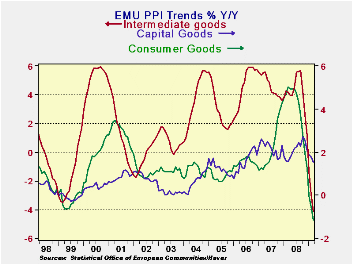 Global| May 05 2009
Global| May 05 2009Sharp, Widespread, PPI Drop Puts ECB On The Spot For A Rate Cut
Summary
The PPI is not the ECB’s mandated inflation variable. The central bank prefers the broader consumer-based HICP. But the drop in the PPI excluding construction at -0.8% in March, at -10.5% over three months (saar), at -12.3% over 6 [...]

The PPI is not the ECB’s mandated inflation variable. The
central bank prefers the broader consumer-based HICP. But the drop in
the PPI excluding construction at -0.8% in March, at -10.5% over three
months (saar), at -12.3% over 6 months (saar) and at a minus three
percent over 12-months is nonetheless a compelling piece of evidence
for the ECB to confront. Capital goods inflation at +1.5% Yr/Yr is the
high inflation reading for the three main sectors. Consumer goods
prices are lower by 1.2% over 12-months and intermediate goods prices
are lower by 4.1% over 12-months. Europeans are not as worried about
deflation as policymakers in the US, yet they can’t deny these trends.
Inflation, its breadth and its trends all point to the nearly
complete absence of anything that could be called inflation. Indeed
there is growing evidence for those who want to worry about that
opposite concern: deflation. On top of that, the European economy is
very weak.
The controversial aspect of this is that Europe’s finance
ministers are not applying any new stimulus and the head of the
European Commission, Jean-Claude Junker, said that no policies except
those that are already approved should be implemented. That appears to
be an oblique warning from Junker to EU countries not to go off on
their own with any new programs of assistance. Even so Junker admits to
a growing unemployment crisis in Europe. Of course Europe has a more
extensive social safety network than the US. But as the EU Commission
and the OECD and the IMF have cuts forecasts the EU Commission has been
prepared to sit idle and wait for the results of its past stimulus
plans to play out. Moreover, the ECB has been content to let the Bank
of England and the Federal Reserve take the more aggressive monetary
policy actions.
So if there is a risk it is that Europe is getting behind the
curve and perhaps, along with that, a growing risk of deflation. The
continuing sharp drop in inflation – indeed, persisting negative rates
of inflation- hint at an ongoing economic unraveling. However, recent
economic data have suggested in several ways that the economic tailspin
had begun to enter a more controlled phase.
In Spain, programs to arrest sharply rising unemployment seem
to be having some impact. In Germany a car scrappage scheme seems to
have boosted car registrations. The EU PMI for manufacturing shows a
rise in that key sensitive cyclical index that suggests the pace of
economic unraveling its slowing and that signal is echoed across Main
EMU countries. So while Europe’s policies may tread a riskier path that
those in the US there is also some evidence of economic responsiveness
to the counter cyclical policies already implemented and of course
there is that cushier social safety net in Europe.
Nonetheless, this drop in the PPI is sharp, the largest drop
in 22 years. It is putting pressure on the ECB and is expected to
result in another rate cut from Europe’s central bank at its next
meeting. Reasons to oppose such a drop are increasingly scarce.
| E-Area and UK PPI Trends | ||||||
|---|---|---|---|---|---|---|
| M/M | Saar | |||||
| E-Area | Mar-09 | Feb-09 | 3-Mo | 6-MO | Yr/Yr | Y/Y Yr Ago |
| Total x Construct | -0.8% | -0.6% | -10.5% | -12.3% | -3.0% | 5.7% |
| Capital Gds | -0.2% | 0.1% | -0.6% | 0.0% | 1.5% | 1.6% |
| Consumer Gds | -0.2% | -0.2% | -5.0% | -4.2% | -1.2% | 5.0% |
| Intermediate&Cap Gds | -0.9% | -1.0% | -14.1% | -13.8% | -4.1% | 4.2% |
| MFG | -0.9% | -0.5% | -8.8% | -13.6% | -5.1% | 5.8% |
| Germany | -0.7% | -0.7% | -10.2% | -6.4% | 1.0% | 3.2% |
| Gy ExEnergy | -0.5% | -0.5% | -5.9% | -5.7% | -1.4% | 2.4% |
| Italy | -0.8% | -0.8% | -10.1% | -14.5% | -4.5% | 6.6% |
| UK | -0.9% | 0.0% | 1.3% | -15.2% | 0.2% | 13.6% |
| E-zone Harmonized PPI ex construction | ||||||
| The EA 13 countries are Austria, Belgium, Finland, France, Germany, Greece, Ireland, Italy, Luxembourg, the Netherlands, Portugal, Slovenia | ||||||
Robert Brusca
AuthorMore in Author Profile »Robert A. Brusca is Chief Economist of Fact and Opinion Economics, a consulting firm he founded in Manhattan. He has been an economist on Wall Street for over 25 years. He has visited central banking and large institutional clients in over 30 countries in his career as an economist. Mr. Brusca was a Divisional Research Chief at the Federal Reserve Bank of NY (Chief of the International Financial markets Division), a Fed Watcher at Irving Trust and Chief Economist at Nikko Securities International. He is widely quoted and appears in various media. Mr. Brusca holds an MA and Ph.D. in economics from Michigan State University and a BA in Economics from the University of Michigan. His research pursues his strong interests in non aligned policy economics as well as international economics. FAO Economics’ research targets investors to assist them in making better investment decisions in stocks, bonds and in a variety of international assets. The company does not manage money and has no conflicts in giving economic advice.






